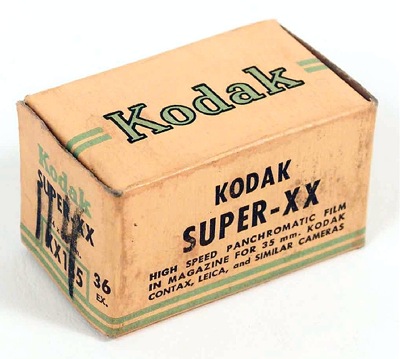 [In a previous Guest Post, military historian Charles Herrick dug out the documentation and painstakingly tracked the route Robert Capa’s films would have taken before John Morris actually got his hands on them in LIFE‘s London office. His analysis made it clear that, in order to meet LIFE‘s deadline for its upcoming D-Day issue, Capa believed he had no choice but to leave the invasion front in order to ensure the timely arrival of his films at LIFE on the evening of June 7.
[In a previous Guest Post, military historian Charles Herrick dug out the documentation and painstakingly tracked the route Robert Capa’s films would have taken before John Morris actually got his hands on them in LIFE‘s London office. His analysis made it clear that, in order to meet LIFE‘s deadline for its upcoming D-Day issue, Capa believed he had no choice but to leave the invasion front in order to ensure the timely arrival of his films at LIFE on the evening of June 7.
But that still left several questions unanswered:
- While on Easy Red, Capa presumably had another option — that of turning his film over to a military courier assigned to that sector of the beachhead for transport to England, according to a plan put in place by Supreme Headquarters Allied Expeditionary Forces (SHAEF). This would have enabled him to stay with the troops and cover the first days of the invasion from the front — the story of a lifetime, a war photographer’s dream assignment. Why didn’t he do so, and what would likely have ensued with his films had he made that choice?
- What system did SHAEF in fact have in place to transmit news reports, photographs, and films generated by accredited journalists from the invasion front? And how did that work out?
So I asked Herrick to grab his pick and shovel yet again, in order to excavate the relevant materials from the military archives.
I find what he dug up both fascinating and illuminating, and hope you will too. The conclusion appears below. Click here for Part 1, here for Part 2, and here for Part 3. — A.D.C.]
•
Legend of the Lost Film (conclusion)
by Charles Herrick
•
Bob Landry’s “Lost” Film
… Unfortunately, the debunking of the “dropped overboard” legend does nothing to explain the absence of D-Day film from LIFE‘s other photographer, Bob Landry. If his films weren’t lost overboard, then what happened to them? The simple answer seems to be: He shot no D-Day photos because he didn’t land that day.
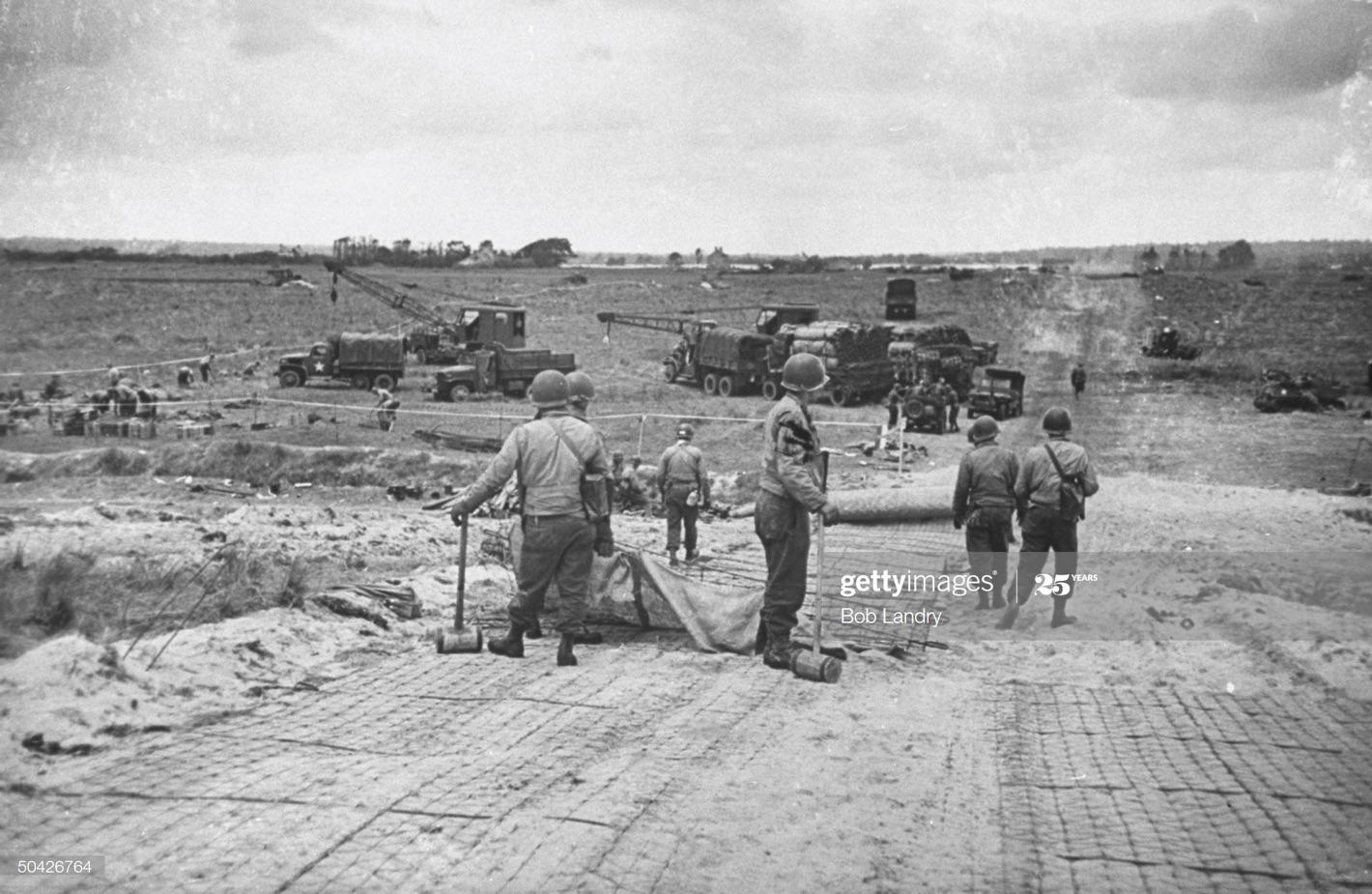
Figure 17. The only known picture by Bob Landry of Utah Beach, probably on June 8, 1944. Engineers are in the initial stages of developing an exit from the beach. Note the wire mesh they have pegged into the sand to provide traction for wheeled vehicles. (https://www.gettyimages.com/detail/news-photo/on-the-second-day-of-the-normandy-invasion-during-wwii-us-news-photo/50426764?adppopup=true )
•
Figure 17 is a photo Landry took, apparently, shortly after landing. It shows engineers developing an exit through the dune line on Utah Beach. The absence of combat troops in the photo indicates that fighting has moved inland, which places this photo at least on June 7, 1944. Furthermore, the absence of logistical and troop movements on the road inland indicates this was not Exit 2, which was opened early on D-Day and immediately became the main artery for troops and materiel heading inland. That would seem to indicate this was either Exit 3 or 4, both of which were cleared of enemy beach defenses on D-Day, but could not be developed by engineers until late D+1 or early D+2 once enemy defenses farther up the coast were eliminated.
Lighting conditions indicate that it was taken about mid-day, which would have been too early on D+1 for engineers to begin work, which in turn suggests that this photo was taken on D+2. This would mean that Landry came ashore on D+2 with the correspondents whose LCT was delayed by fire during the initial Channel crossing (see previous installment), taking this photo as he began to head inland.
Alternatively, it is possible he landed on D-Day and remained on Utah Beach for the first 48 hours, then made this photo as he headed inland. But it seems out of character for the man to stay on the beach for two days, given the dramatic fighting that was taking place inland in the effort to link up with the still-isolated paratroopers. Landry was an excellent, experienced war photographer who knew where to be in order to get a picture.
Furthermore, if he had spent two days on the beach, I would expect more than just this one photo of the scenes there. Instead, this one picture has the appearance of a brief photo opportunity he encountered as he hurriedly passed by on his way to the inland front.
•
The D+2 alternative is also supported by Landry’s photos taken in Sainte-Mère-Église, about 5 miles inland of Exits 3 and 4 from Utah Beach. (Figure 18) Those photos predominantly show soldiers from the 4th Infantry Division, mixed in with paratroopers of the 82nd Airborne Division. Although the 4th Division did make contact with the paratroopers at Sainte-Mère-Église late on D+1, that village was the base for the paratroopers’ see-saw battles facing north that day, with the 4th Division fighting on their flanks late in the day. The paratroopers were not relieved until the next day, when they pulled out and reoriented to the west.
•
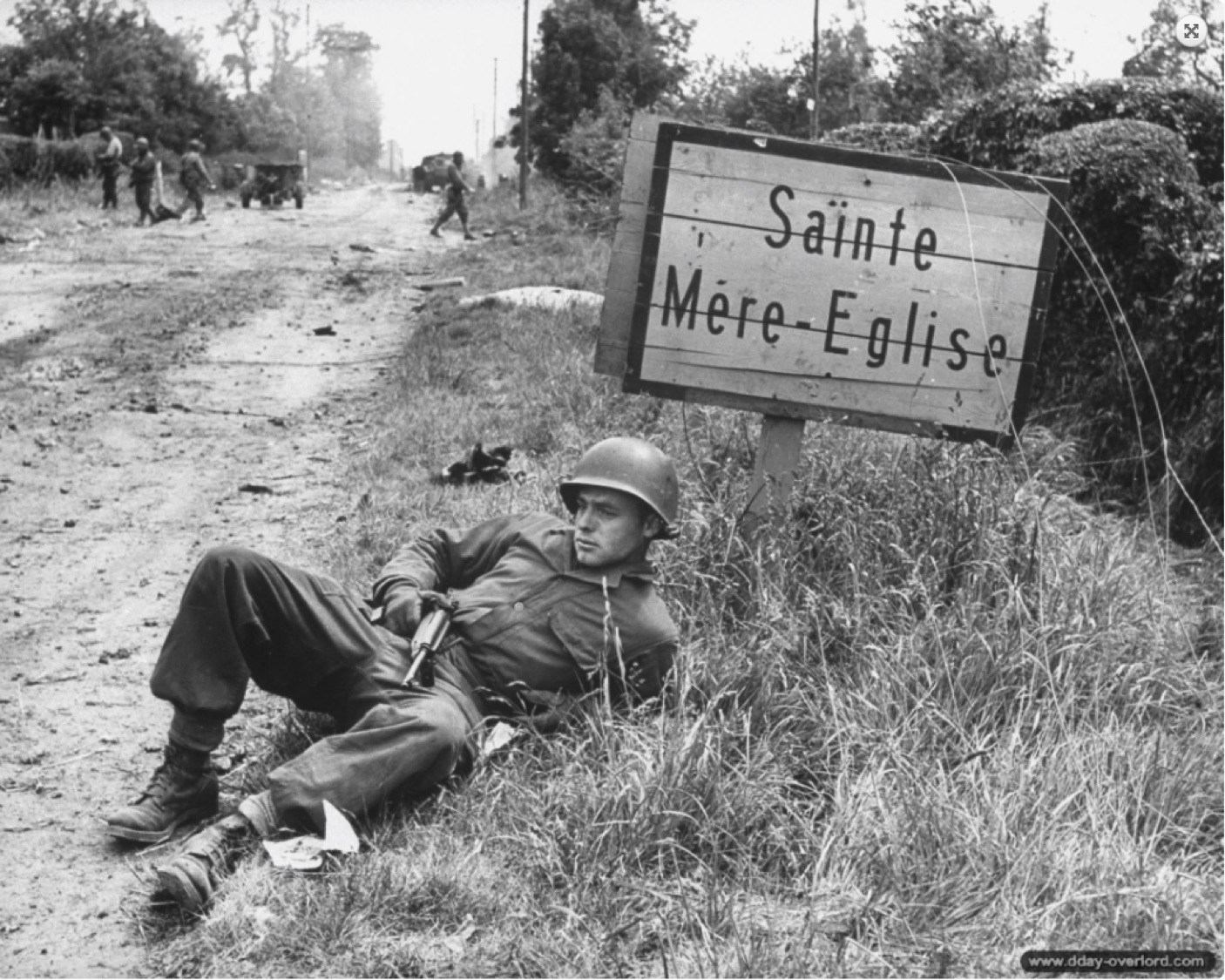
Figure 18. A photo taken by Bob Landry on the outskirts of Sainte-Mère-Église. Although the picture credits place this on June 7, the 4th Division troops seen here and in some of his other pictures suggest that it was taken on June 8 at the earliest. (Getty Images https://www.gettyimages.com/detail/news-photo/full-length-image-of-an-american-gi-reclining-on-a-patch-of-news-photo/3232009?adppopup+true&uiloc+thumbnail_more_search_results_adp)
•
Landry’s photos indicate that the paratroopers had mostly pulled out of the village and the 4th Division was in the process of taking over, which would place them as being taken on D+2. (Although the information for the above image provided by Getty Images date it June 7 — D+1 — that can’t be taken as authoritative; Getty Images attribute a number of Landry’s other Sainte-Mère-Église photos as shot five days before D-Day, on June 1, 1944, or even five months before D-Day, on January 1, 1944.[1])
•
Although not conclusive, these several points indicate that Landry landed not on D-Day, but most likely on D+2. Unfortunately, there’s little evidence against which to test this, and John Morris was extraordinarily vague and often inconsistent about Landry’s role in covering the invasion. Quite bluntly, the relationship between the two men had been strained ever since they worked together three years previously in Hollywood.
We do have one clue that gives us a hint of Landry’s invasion experiences, as well as of Morris’s pettiness. LIFE‘s June 26, 1944 issue carried a brief summary of its correspondents’ activities on D-Day. While the rest of the accounts were written by the correspondents themselves, the very short paragraph on Landry was a third-person tale, no doubt written by Morris. It clearly indicates that Morris had received at least two messages and two sets of film from Landry by the time he sent the material he’d collected for that issue to the New York office.
•
It begins, “Messages from this photographer [Landry] were brief. The first one received by the London office, along with his pictures, stated ‘I have lost my shoes.'” [Emphasis added.] The reference to the loss of shoes was a petty slight that became a standard swipe at Landry’s memory throughout Morris’s career, repeated in many of his retellings of his version of the D-Day story. It does, however, serve as a time stamp, indicating that this message was the first Landry sent back from the beach. (Note: It wasn’t uncommon to lose shoes wading ashore through wet, sucking sand, and Landry would have only included that detail in his first packet to the rear; it would have been old news by the time he sent off later packets.)
Morris’s description of the second packet is equally distinctive. “The latest message from Landry reported …” That means this was at least the second message from Landry, and the reference to Army nurses coming ashore clearly is linked to Landry’s pictures featuring those nurses; that message and those photos must have reached Morris in the same package. A photo of the nurses was printed on page 32 of the June 26 issue. This provides a clue as to when these photos were taken. The caption indicates that the nurses came ashore on June 10, walked inland and went right to work.
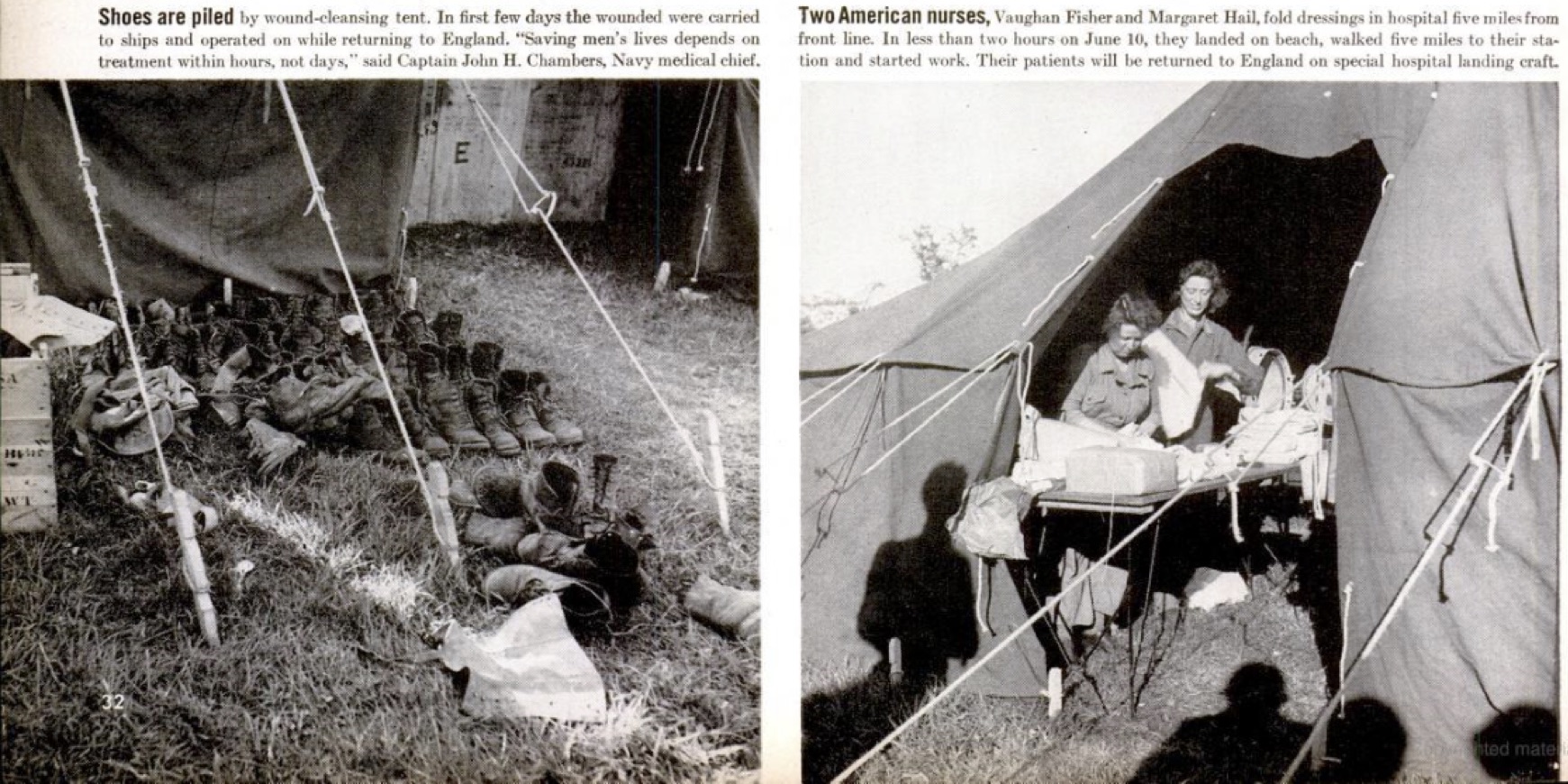
Figure 19. Bob Landry, Normandy field hospital, LIFE magazine, June 26, 1944 issue, p. 32 (detail). Note shadows in foreground of image on right.
In fact, two field hospitals with staff, including female nurses, landed on June 7 and 8. The hospitals’ equipment was scattered, however, and they did not become operational until June 10 and 11, respectively.[2] Landry’s photos (Figure 19) show that one hospital is up and functioning; the group of shadows in the foreground of the picture of the nurses indicates he was part of a press tour of the newly operational hospital. So a date of June 10 or thereafter for this image is correct.
But if Morris received two sets of photos from Landry, what happened to the first set? The answer is this: both sets were printed in that June 26 issue. Landry’s photo on page 21 of the opening spread of that issue’s feature, “Our World-Wide War,” shows an incident of infantry mopping up in Sainte-Mère-Église. (Figure 20)
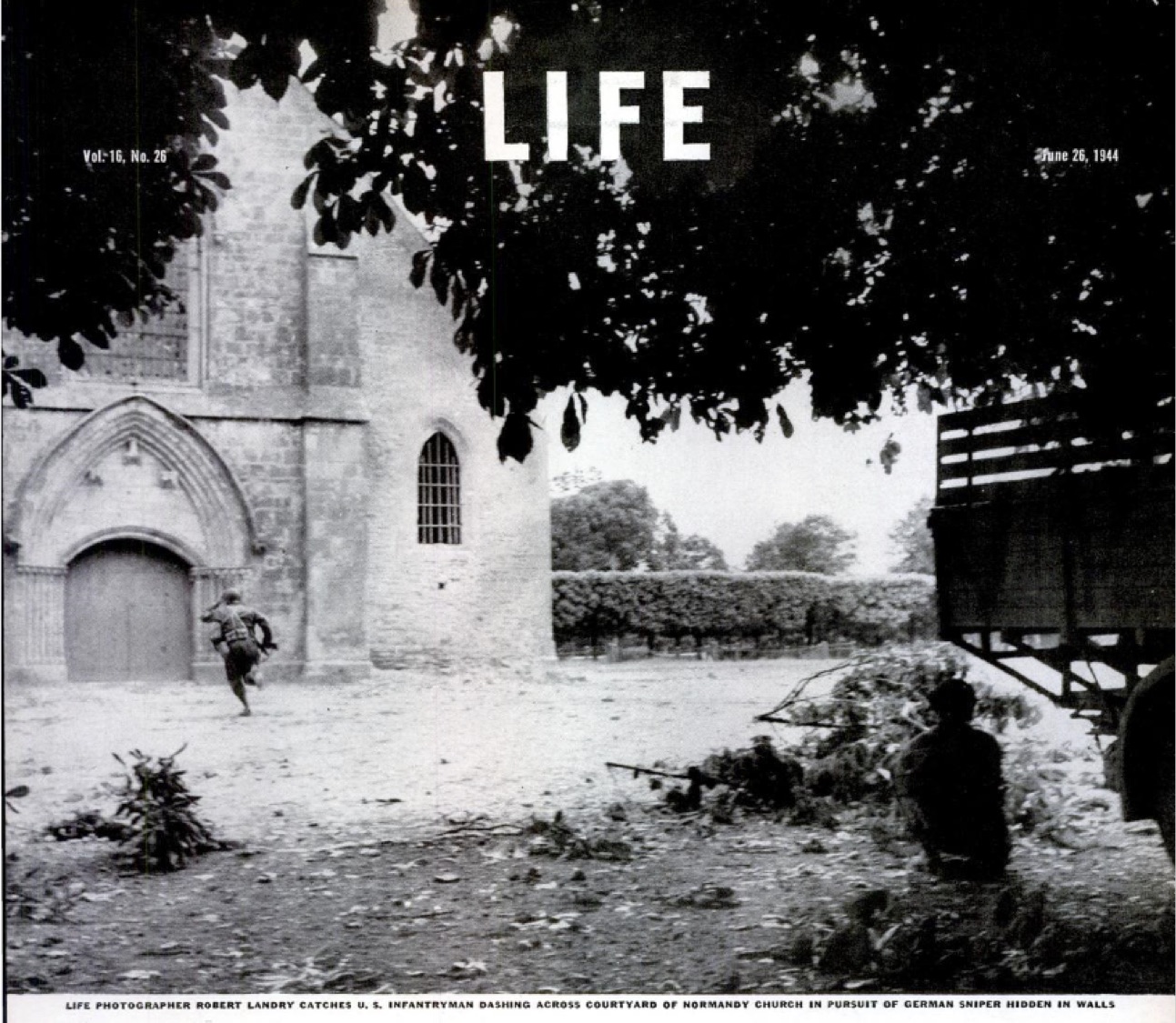
Figure 20. Bob Landry, infantry mopping-up action, Sainte-Mère-Église, LIFE, June 26, 1944 (detail).
His photos on pages 26 and 27 (Figure 21), depicting the corpses of both American and German soldiers still lying about the battlefield — as well as others not printed in that issue — show the immediate aftermath of combat in and around Sainte-Mère-Église, and were likely taken on June 8 (D+2). I would suggest that these, along with the beach exit shot discussed above, were part of Landry’s first film packet and accompanied the message to Morris about losing his shoes.
•
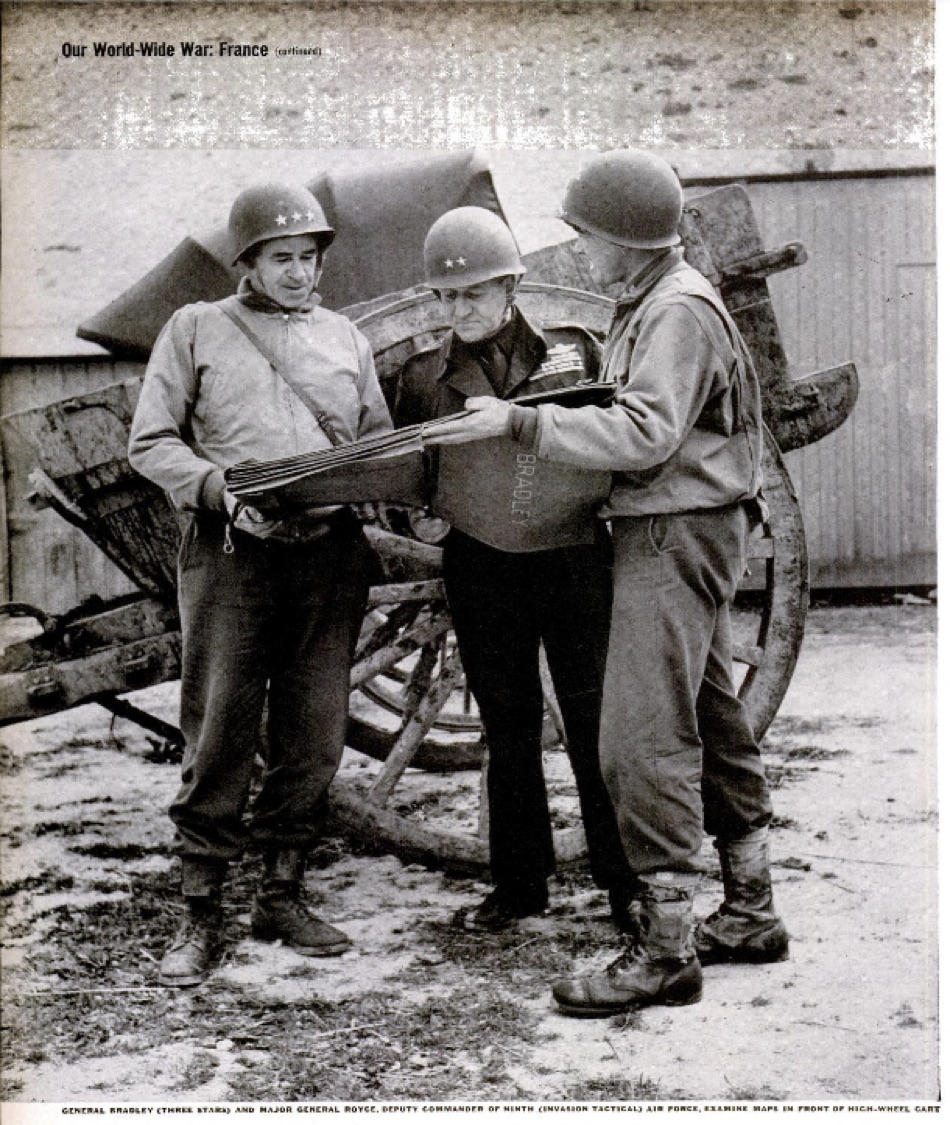
Figure 22. Bob Landry, posed photo of Generals Bradley and Royce Normandy, LIFE, June 26, 1944 (detail).
The remaining photos included in the June 26 LIFE issue show a different side of life at the front. The photos of the field hospital (including a third not seen here) indicate that combat had moved well past Sainte-Mère-Église, the hospital is functioning, the initial objectives have been achieved, and a relatively safe rear area has been secured. The photo of Gen. Omar Bradley talking with Major General Royce of the U.S. Army Air Force conveys the same message; it also appears to have been taken on June 10, the date on which Bradley left the USS Augusta with a group of correspondents for a tour of the Utah beachhead.[3] Collectively, these photos appear to be part of Landry’s second packet of film.
•
Taking the foregoing into account, I would suggest that Morris’s summary is correct in its indication that he had received at least two messages with separate film packets from Landry by that date (June 15). The fact that images from both packets were printed in the same issue should not blind us to the likelihood that they were taken on different dates under much different conditions. Landry’s landing film was not lost, nor is it missing. It’s right before our eyes. We don’t recognize it as such because we expect his first film to show scenes from D-Day. But there is no Landry film from D-Day, for the simple reason that, apparently, he did not land on D-Day. Certainly there is no evidence that he did.
[Editor’s note: Based on the fixed schedule for courier flights to the U.S. and LIFE‘s deadlines that, according to Morris, governed the production of the D-Day issue, he would have sent out all materials for the issue datelined June 26 by 9 a.m. on the morning of June 15. That issue of LIFE would have closed on Saturday, June 17, gone to press on Sunday, June 18 and hit the stateside newsstands on Monday, June 19. — A.D.C.]
•
One last point in Morris’s brief summary should be noted. It disclosed absolutely no details of Landry’s arrival in France. There wasn’t the slightest hint that any of Landry’s film was lost, much less dropped overboard. Nothing about his mission, when he landed or where he landed. There was only the reference to Sainte-Mère-Église, vague enough even to suggest that Landry was part of the parachute assault that seized the village. This began a 70-year practice in which Morris cloaked Landry’s invasion activities in equal parts silence and misinformation.
It was not until Morris’s interview with Jozefa Stuart (which took place after Landry’s death in 1960) that he put forward the idea that Landry’s invasion film had disappeared, blaming its loss on a dispatch boat that sank while crossing the Channel. Again, he omitted all details of Landry’s landing. [Editor’s note: Commissioned in the early 1960s by Cornell Capa, this unpublished interview transcript rests in the Robert Capa and Cornell Capa Archives of the International Center of Photography in New York City. — A.D.C.]
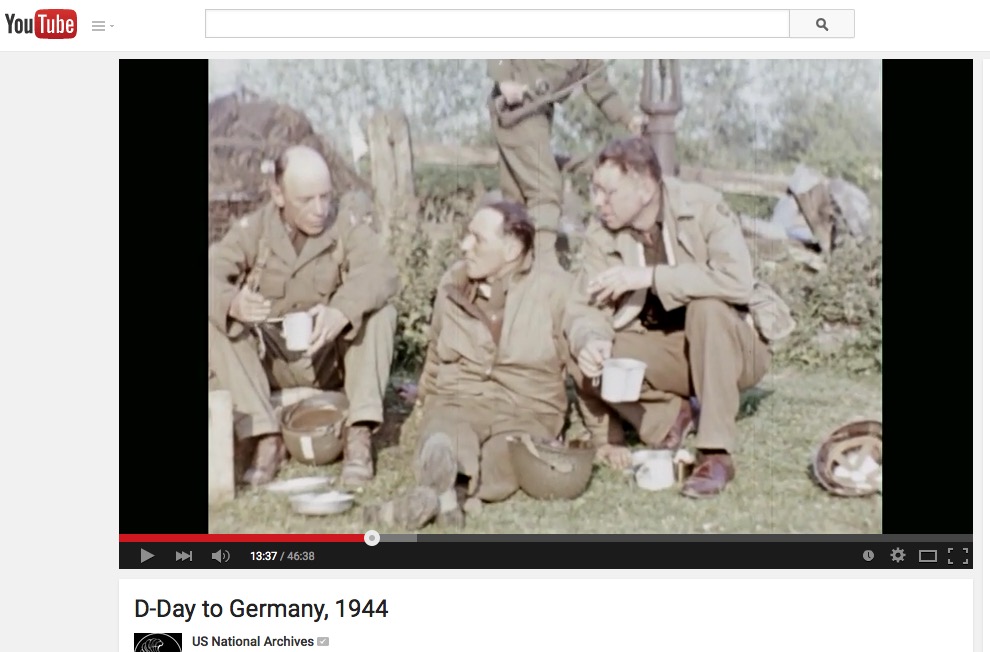
Bob Landry (r), with shoes, Sainte-Mère-Église, as seen in Jack Lieb’s film, “D-Day to Germany, 1944.”
About 35 years later, Morris had a different tale to tell. In his 1998 memoir Get the Picture he again neglected to mention which unit Landry covered, at which beach he landed or when he stepped ashore. But in this version Morris backtracked on his earlier story. He omitted the sunken dispatch boat element and instead said “Landry’s film — and his shoes — somehow got lost.” By linking the loss of film to the loss of shoes, Morris was clearly implying the film was lost due to Landry’s carelessness (a point only partially clarified some 73 pages later). Morris also misleadingly implied that on D+1 he knew of Landry’s loss and was therefore wholly reliant on Capa to come through with D-Day pictures.[4] In fact, he received no word from Landry that day.
Think about that. For 70 years Morris studiously avoided mentioning any details about Landry’s D-Day assignment. No unit. No beach. No landing date or time. It was only in his May 31, 2015 Financial Times interview with Simon Kuper that Morris finally placed Landry at Utah Beach, doing so only in the process of reiterating the “dropped overboard” legend. Over those same years, Morris provided four different stories in accounting for Landry’s film: first, he received it with the message about lost shoes; second, it was lost when a dispatch boat sank; third, the film was lost with Landry’s shoes; and fourth, a clumsy courier dropped it overboard.
Richard Whelan, Capa’s official biographer, proved no more helpful. In his biography of Capa, he placed Landry accompanying “the paratroopers.”[5] This was apparently a reference to LIFE having nominated Landry — and, incidentally, Capa as well — to jump in with the paratroopers behind Utah Beach on D-Day; in fact, however, both men opted out of attending the mandatory parachute course and were reassigned to seaborne units for the invasion.[6] Whelan changed this story in his later book. In that second telling he placed Landry landing “with the first wave on Utah Beach.”[7] As was the norm for Whelan, he provided no source for either claim.
What, if anything, are we to believe of this?
I for one choose to discount the evolving details stemming from a 70-year-old grudge held against Landry by Morris. This project has amply documented Morris’s tendency to revise his accounts whenever he saw fit, and it appears he did so once again regarding Landry. Instead I place far more credence in the contemporary evidence of Morris’s own words and Landry’s photos as they appear in the June 26 issue of LIFE.
While I believe there is credible evidence to support the conclusion that Landry first stepped ashore at Utah Beach on D+2, it cannot be proven to any degree of certainty. By the same token, however, there is absolutely no proof that he landed on D-Day, or did so in time to pass his film off to Maj. W. A. Ulman. Furthermore, the photos identified above indicate that all his film of the invasion survived, enabling some of it to be published. So the tale asserting that Landry’s film was lost overboard by a careless courier has absolutely no foundation in fact, and is largely repudiated by the facts that we can establish.
(Author’s note: I am indebted to Tom Hogan for the background information on W. A. Ulman and the two related images used in the article. Hogan also provided a critical second set of eyes in the herculean task of reviewing many, many hours of archival film clips. — C.H.)
•
Postscript
While the National Archives constitute an amazing resource, accessing their holdings is not the easiest process. Only a fraction of their documents and images are online; locating specific files can require an advanced degree in hide-and-seek.
 Most motion picture cameras used by WWII combat photographers used 100-foot rolls of film. Segments of those rolls were usually selected, extracted, and incorporated into newsreels and full-length films for immediate and subsequent release to the public. Over the ensuing decades some clips have found their way into multiple films and videos about D-Day. As a result, unfortunately, it isn’t always easy to associate a surviving clip with a specific cameraman or detachment.
Most motion picture cameras used by WWII combat photographers used 100-foot rolls of film. Segments of those rolls were usually selected, extracted, and incorporated into newsreels and full-length films for immediate and subsequent release to the public. Over the ensuing decades some clips have found their way into multiple films and videos about D-Day. As a result, unfortunately, it isn’t always easy to associate a surviving clip with a specific cameraman or detachment.
In recent years several web-based services have helped fill the gap with extensive online libraries of archived D-Day motion picture film. Much of their content consists of digitized versions of the original, unedited rolls of film, usually including the cameraman’s slate board. Photos Normandie and Critical Past are especially valuable resources on which my Guest Posts for this project have relied heavily.
Nevertheless, a large percentage of film shot during the Normandy invasion cannot be reliably linked to a slate board, an identifiable cameraman, or even a particular photo detachment.
At least with motion picture film we can sometimes see the slate board in the opening frames of the film. That isn’t the case with the hundreds of still photos of the Normandy invasion (and, more broadly, the war) that exist. If a researcher is extremely lucky, he can find an image with its original caption, complete with photographer’s name. But since it was military policy not to credit still photos to the individual uniformed cameramen who took the shots, finding reliable credit information is rare.
This problem has been exacerbated many times over by the use and reuse of photos with incrementally less reliable credit information. Thus a photo taken off Omaha Beach ends up in an article about Utah Beach, and becomes incorrectly attributed to that location. Or a picture taken early at Omaha Beach is credited to a photographer who actually landed on Utah Beach, as is the case with a well-known shot often credited incorrectly to Peter J. Carroll.
It is only by dint of careful examination of a photo and comparison of it to the known cameramen in that vicinity at that time that we can identify the true context and man behind the camera. But only sometimes. Far too much of the photographic record will forever remain anonymous. We undoubtedly have film from a good many more cameramen and more detachments than we have been able to identify in this post, but we’ll never know the full extent. — C.H.
•
[Editor’s note: It stands to reason that, had a duffel bag full of still and motion-picture film and written news reports — or a dispatch boat loaded with same — vanished beneath the waves of the English Channel on D-Day or D+1, the civilian correspondents who had produced that historic documentation would have lamented that devastating loss immediately and thereafter. Yet not only do the military records not indicate any such disaster but the public record contains no such claim by any of the journalists assigned to the invasion. —A.D.C.]
•
Notes:
[1] See for example: https://www.gettyimages.com/detail/news-photo/two-german-soldiers-lean-up-against-a-wall-on-the-outskirts-news-photo/3312650?adppopup=true and https://www.gettyimages.com/detail/news-photo/news-photo/50492263?adppopup=true.
[2] Graham A. Cosmas and Albert E. Cowdrey, Medical Service in the European Theater of Operations, The United States Army in World War II, The Technical Services, Washington, DC (1992), p. 221.
[3] Steven L. Ossad, Omar Nelson Bradley, America’s GI General, 1891-1983, University of Missouri Press (2017), p. 190.
[4] John Morris, Get the Picture, A Personal History of Photojournalism, Random House, New York (1998), p. 6.
[5] Richard Whelan, Robert Capa, A Biography, Alfred A. Knopf, New York (1985), footnote to p. 210.
[6] Barney Oldfield, Never a Shot in Anger (Capra Press, Santa Barbara, 1986), pp. 55-56.
[7] Whelan, This is War! Robert Capa at Work, Steidl/ICP (2007), p. 240.
•
Text copyright © 2020 by Charles Herrick. All rights reserved.
•
(For an index of links to all posts in this series, click here.)
•
 Charles Herrick joined the U.S. Army in 1970 and graduated from the U.S. Military Academy at West Point in 1974. Commissioned in the Infantry, he earned the Ranger tab and Master Parachutist’s wings. He served in a variety of positions from company grade officer to the Pentagon. He earned the Combat Infantryman’s badge while assigned as the Operations Officer of the 193rd Infantry Brigade in Panama in 1989, and later graduated from the U.S. Army War College.
Charles Herrick joined the U.S. Army in 1970 and graduated from the U.S. Military Academy at West Point in 1974. Commissioned in the Infantry, he earned the Ranger tab and Master Parachutist’s wings. He served in a variety of positions from company grade officer to the Pentagon. He earned the Combat Infantryman’s badge while assigned as the Operations Officer of the 193rd Infantry Brigade in Panama in 1989, and later graduated from the U.S. Army War College.
Since retiring from the Army in 1996, Herrick has continued to work on defense issues as a contractor in East Asia, Latin America, the Balkans, Africa and Central Asia. He holds an MBA from the University of California at Los Angeles. He lives in California with his wife, where he pursues his passion for military history. To contact Charles Herrick, click here.


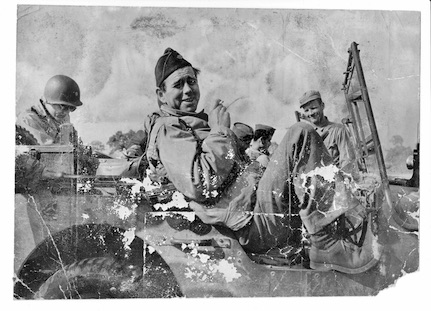
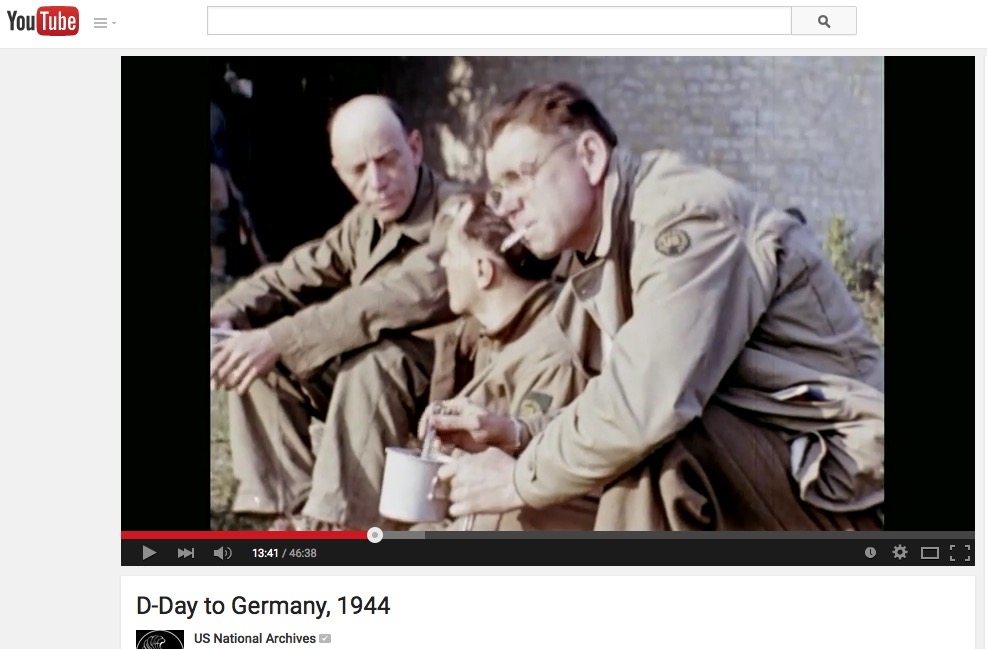
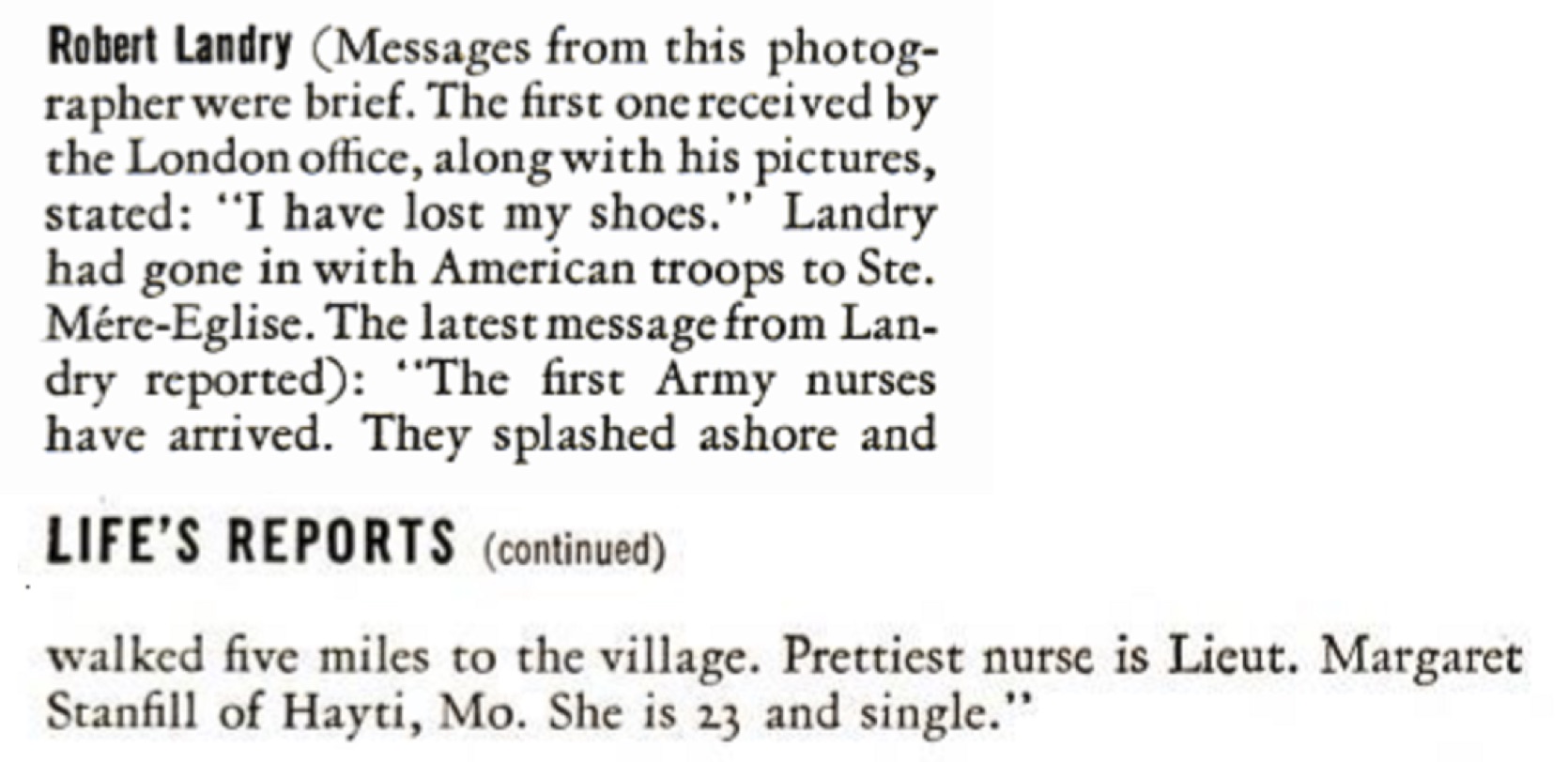
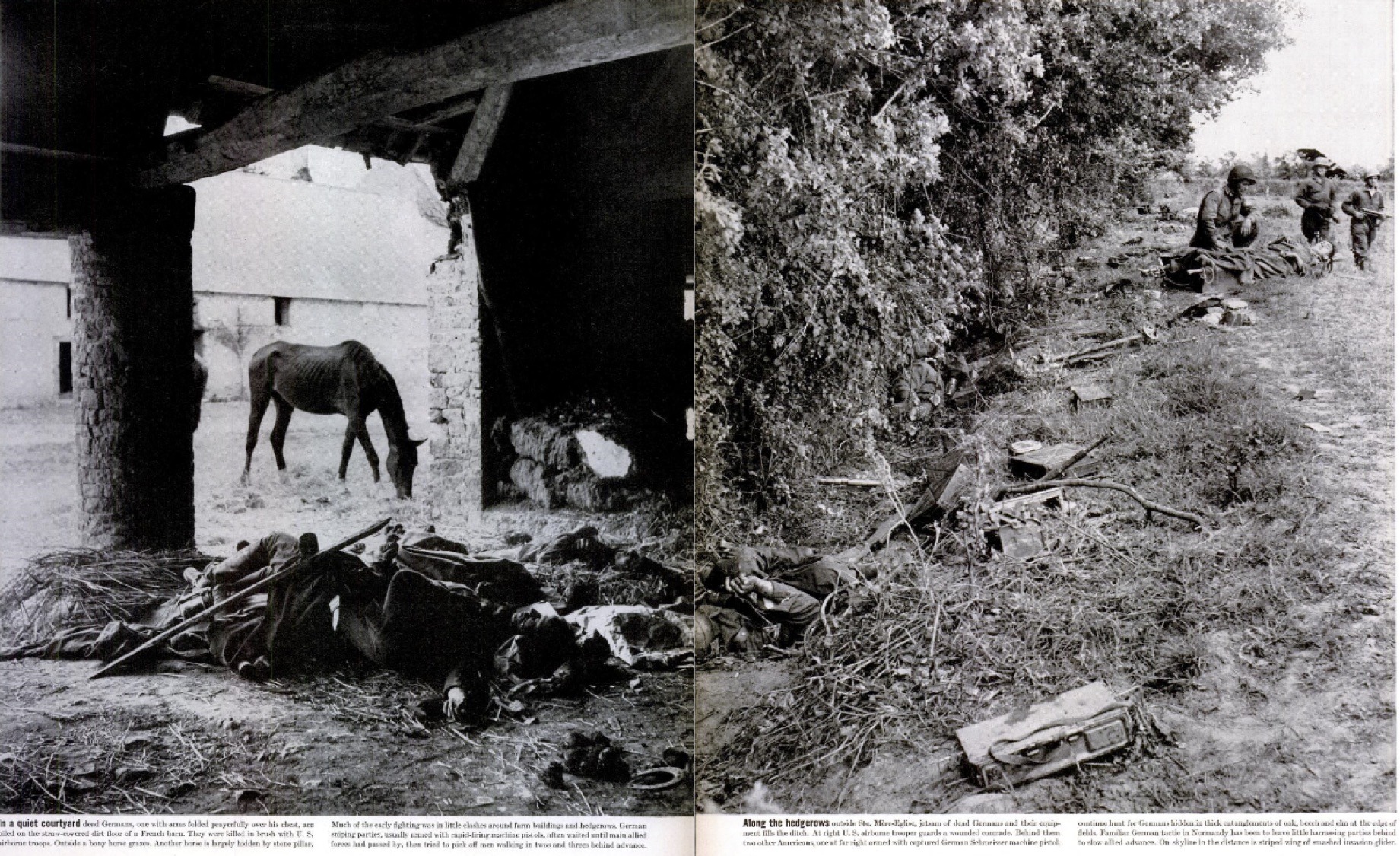
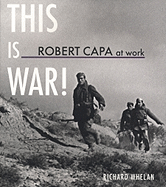




There’s nothing like a dead horse that requires beating.
Unless it’s a loose end that needs tying up.
My thanks to Mr. Herrick for his in-depth analysis of the Capa D-Day myths, and his engaging accounts there of. With excellent footnoting and multiple side stories, it makes for a tour de force in journalistic sleuthing and investigative reporting. I think Lt. Col. Ulman would be proud of your team’s accomplishments, and gratified with your vindication of his name and reputation. As an investigative journalist, Mr. Ulman might also find the title of his early movie manuscript, self-described as “a poorly typed and very amateurish fabrication called “Treachery on the Sea’ or ‘Back From the Depths’” more than a little ironic! Best wishes on your team’s quest for a wider audience, and in overcoming entrenched fictions with the force of truth and knowledge. Perhaps one of Mr. Ulman’s fictitious titles will yet make it to the silver screen!